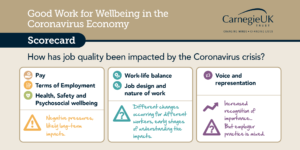Gail is the guest speaker for the third in our popular Business Leaders’ Council webinars on ‘Good Work for Wellbeing in the Coronavirus Economy’ on Friday 12 February from 12.00 – 1.00pm, supported by BUPA, Hastee and Maximus UK.
The webinar will focus on:
- How to ensure the best possible jobs recovery and sustain the ambition of good work for all.
- How to balance the goals of sustaining employment and improving job quality, so that work improves wellbeing for many more people.
- The role of government in supporting employees and employers.
- Action employees can take in these challenging times.
The coronavirus pandemic has severely impacted lives and livelihoods. Millions of workplaces have been shut down and workers furloughed, with business models and ways of working have been disrupted on a near-universal scale. But in the last year we have also seen labour market interventions and business innovations that were previously unimaginable, and the rise of calls to build back a better labour market.
So when we think about ‘how can we ensure the best possible jobs recovery from Covid-19?’ we need to respond to both aspects of the question: considering both the quantity and quality of jobs.
There has rightly been a major focus on protecting employment during the pandemic. Being in poor quality work – jobs that are low-paid, unsafe, insecure and lacking a voice or a sense of control – also exerts a negative toll on wellbeing and the sustainability of work.
If we don’t actively seek to embed ‘good work’ through the pandemic and the recovery, we risk seeing even greater worker insecurity, poverty and the public discontent that followed the last recession. We fail to reward the sacrifices that all citizens, but especially key workers, have made during this time. And we risk the economic recovery, because the evidence shows that better quality work makes workers more productive.
But how can we balance the goals of sustaining employment and job quality, when businesses, governments and individuals are under such heightened pressure from tackling the pandemic?
First, we need to understand what the substantial job quality challenges are that need to be addressed in tandem with the employment challenge? The Carnegie UK Trust investigated this in 2020 using our seven dimension job quality framework for our analysis.
Wellbeing scorecard to assess impact
The impacts have been different depending on personal characteristics, occupation and sector, but we produced the following scorecard to assess the issues at a glance:

Another consideration is who can influence the changes happening to pay, contract type, job design and work-life balance? Our report sets out a package of proposals to influence job quality now and in the medium term, with government, employers and civil society all needing to play a part.
While under considerable pressures, employers can and do make active choices that improve job quality (or at least not to make working lives harder), reaping the benefits in employee engagement and productivity. For example:
- Employers can set up meaningful voice and consultation channels, to ensure their workers are informed and able to express their views and knowledge about changes at work.
- They can draw on the range of remote working good practice guidance that exists to try to make remote working lives more balanced and fulfilling.
- Health, safety and psychosocial wellbeing have moved to the top of the job quality priority list during the pandemic, and there is much employers can do to ensure staff are and feel adequately protected and supported if they are delivering public-facing services, or need to take time off through sickness.
Making working lives better is a big part of how we get through the experience of this pandemic together, and the ambition we should take into the economic recovery.
Watch the webinar
Good work for wellbeing in the coronavirus economy
